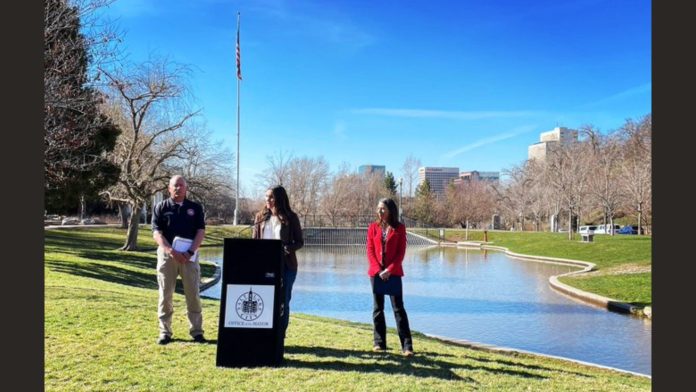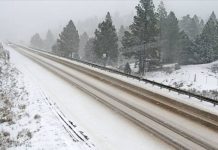
SALT LAKE CITY, Utah, April 11, 2023 (Gephardt Daily) — Mayor Erin Mendenhall says decades of investments in drainage infrastructure have Salt Lake City “more prepared this time around” for potential flooding from spring runoff than in 1983.
Forty years after record snowfall led to flooding throughout the state, Salt Lake City officials are touting improvements made to reduce flooding risks while encouraging residents to be prepared and protect their homes.
“We’ve made significant infrastructure investments since the floods of 1983 that make us more prepared this time around,” Mendenhall said. “We know this is a big concern for our residents, and we’re taking it seriously in our planning and preparation.”
Utah Division of Emergency Management officials note similarities between conditions in 1983 and 2023. Utah saw its highest snowpack with snow water equivalent on record this year with 30 inches, topping the previous record of 26 inches in 1983.
Isolated incidents of flooding already are occurring, with potential for widespread flooding, depending on the temperatures and rate of melt and runoff, state emergency management officials said.
“From a robust stormwater system to debris basins and the addition of Little Dell reservoir, Salt Lake City and our flood control partners, including Salt Lake County, have been preparing for decades to ensure the best possible outcomes for our residents in high snowpack years,” Mendenhall said.
Since the ’83 floods, Salt Lake City has added debris basins along City Creek that allow rocks, branches and other debris to settle and be removed before becoming a problem. During the 1983 spring runoff, the storm drain carrying City Creek flows on North Temple became clogged with debris that extended four city blocks, city officials said.
Other drainage system improvements in Salt Lake City include:
- Grate improvements in Memory Grove to prevent potential backups.
- Piped drainage system improvements to allow for better conveyance of spring runoff.
- Construction of Little Dell Reservoir from 1987-1993 as a flood-control and water-storage facility.
“The nature of this year’s spring runoff will be dependent on the weather and temperature as we enter the runoff season,” said Laura Briefer, Salt Lake City’s director of public utilities. “We are hopeful for a more measured runoff given the large accumulation of snow at the mid and high elevations, but [we’re] planning conservatively for worst-case scenarios.”
City officials are working with Salt Lake County to monitor climate conditions and prepare for possible flooding, Briefer said.
“Snowpack and runoff data prepared by agencies such as the National Weather Service, Colorado Basin River Forecast Center and others are also important to our runoff management strategy to help mitigate the potential risk of flooding,” she said.
In addition to the city’s infrastructure improvements and ongoing flood-control efforts, residents can help reduce flooding risks by preparing themselves and their homes. Residents can learn about flood zone locations, flood preparedness tips, flood insurance and additional information about this year’s spring runoff at Salt Lake County’s flood preparedness website, slco.to/floodprep.
“As we enter this time of uncertainty surrounding potential flooding, Salt Lake City Emergency Management wants to remind everyone to have an emergency plan in place should their home be affected by flooding,” said Salt Lake City Fire Battalion Chief Richard Boden, the city’s emergency manager. “This includes having extra nonperishable food items, extra water, medications and other important necessities stocked for up to 96 hours.”
Tracie Harrison, the Utah Division of Emergency Management’s floodplain manager, also encourages Utahns to purchase flood insurance.
“Flooding is the most common natural disaster in Utah. Yet most people are unprepared for a flooding event,” Harrison said. “Purchasing flood insurance is just one way you can prepare and recover more quickly.”
Other ways Utahns can prepare for possible flooding, DEM officials say, include:
- Understand the risk. Wherever it rains, it can flood — even in areas outside a mapped flood zone.
- Protect valuables by taking videos and pictures of them; use waterproof containers to store important documents; and store valuables on a higher floor when possible.
- Find out where sand and sandbags are available.
“We purchased and distributed almost 1.5 million sandbags around the state. We are also providing emergency managers with information on the disaster documentation process should flood damages occur,” said Utah Division of Emergency Management Director Kris Hamlet. “It is important, however, that everyone, not just emergency managers, do their part to prepare for flooding, or for any other type of hazard.”
DEM officials also remind Utahns to “turn around, don’t drown” when faced with fast-moving water in rivers or streams, or while crossing roads and bridges. Just 12 inches of fast-moving water can knock a person off their feet, while 18 inches of fast-moving water can float a car, state emergency management officials said.
Homeowners and renters can find more information about protecting their their homes from flooding at dem.utah.gov.






